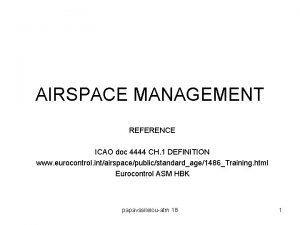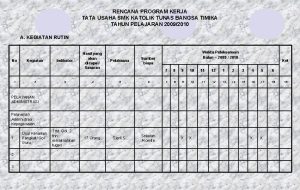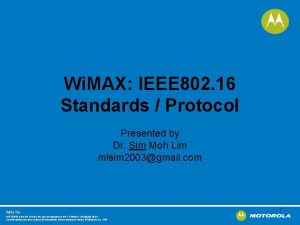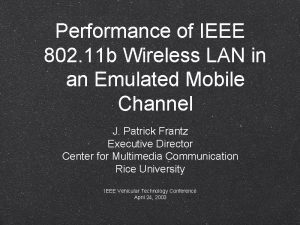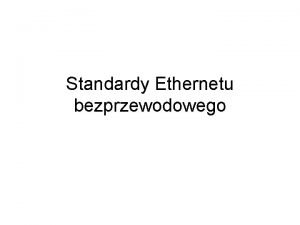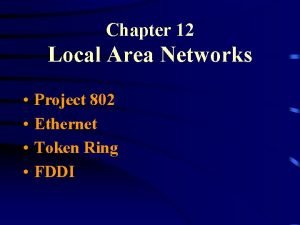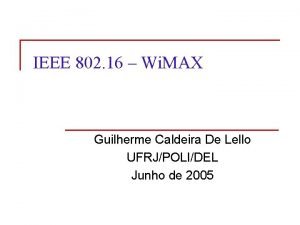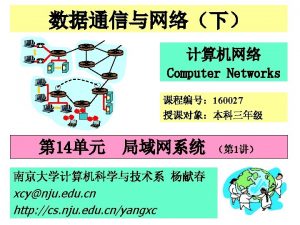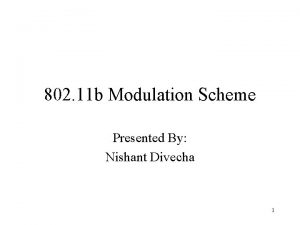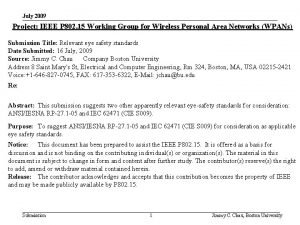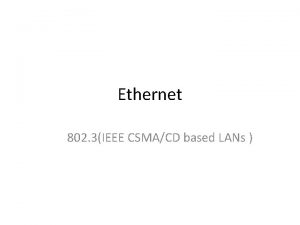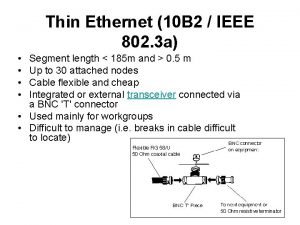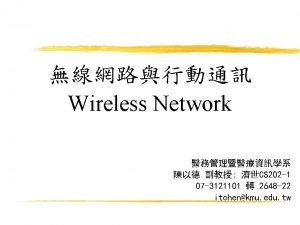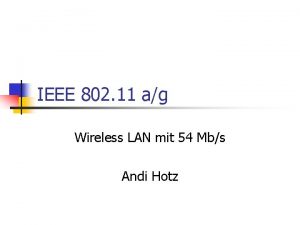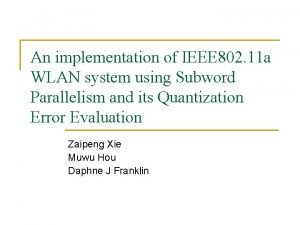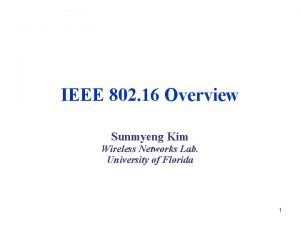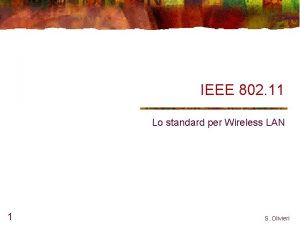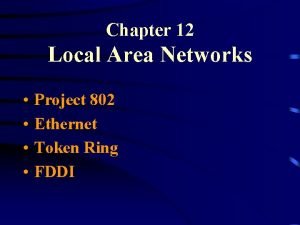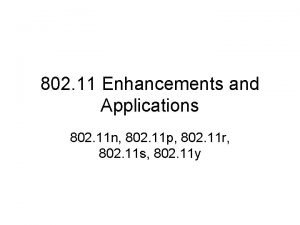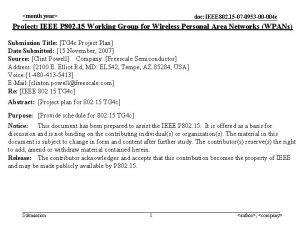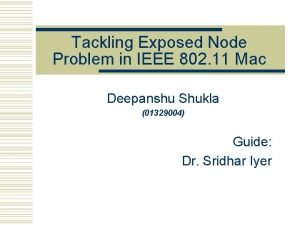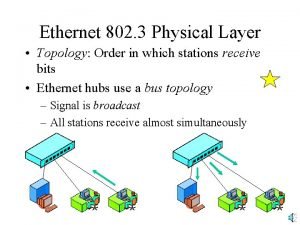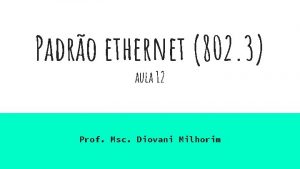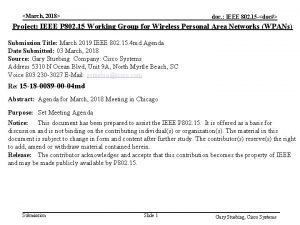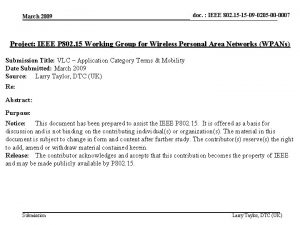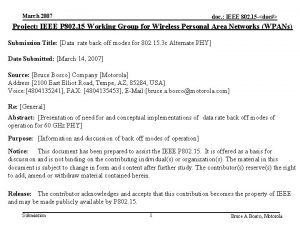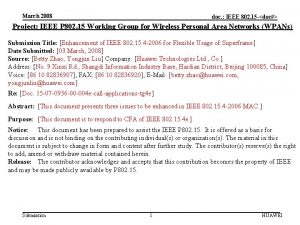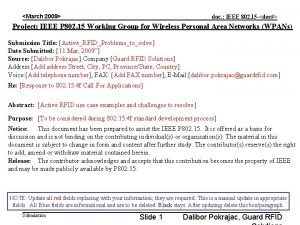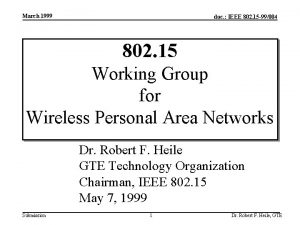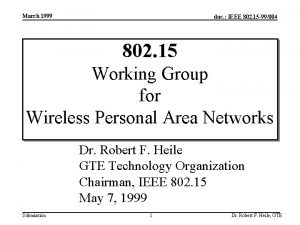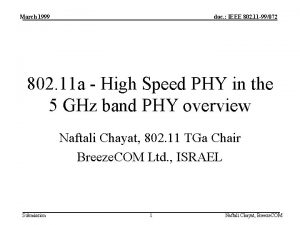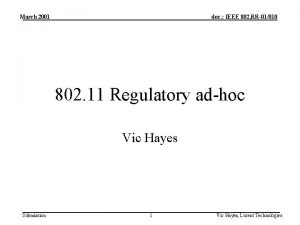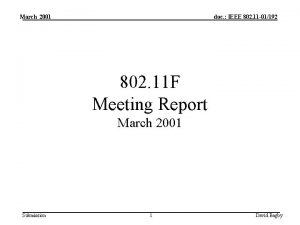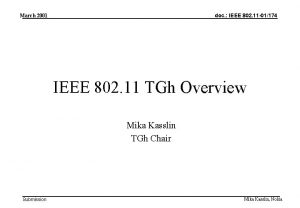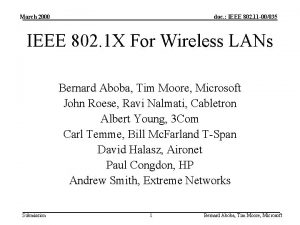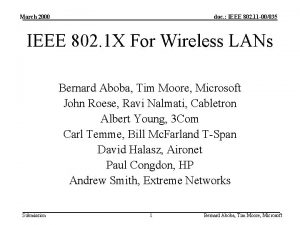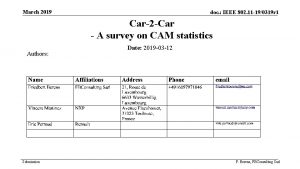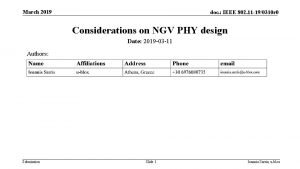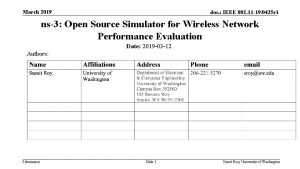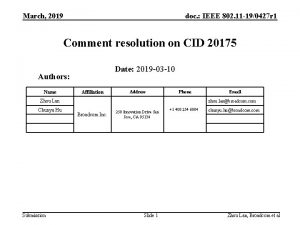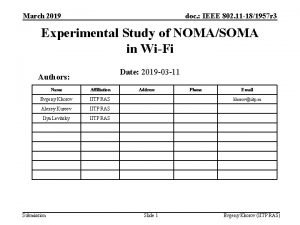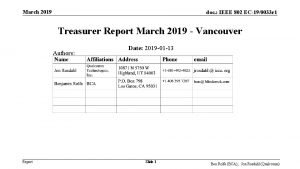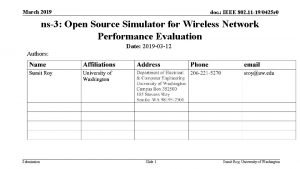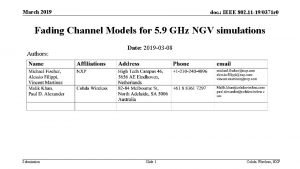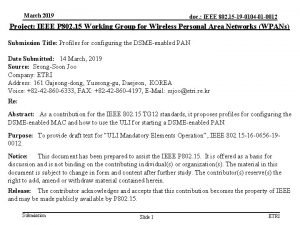March 2019 doc IEEE 802 15 15 17










































- Slides: 42

<March 2019> doc. : IEEE 802. 15 -<15 -17 -0113 -10 -0012 Project: IEEE P 802. 15 Working Group for Wireless Personal Area Networks (WPANs) Submission Title: [802. 15. 12 – Conceptual Overview] Date Submitted: [7 November 2017] Source: [Pat Kinney], Company: [Kinney Consulting] Address [Chicago area, IL, USA] Voice: [+1. 847. 960. 3715], E-Mail: [pat. kinney@kinneyconsultingllc. com] Re: [Information on IEEE 802. 15. 12 for IETF coordination effort] Abstract: [High Level Overview of current state of IEEE 802. 15. 12] Purpose: [For informational purposes only] Notice: This document has been prepared to assist the IEEE P 802. 15. It is offered as a basis for discussion and is not binding on the contributing individual(s) or organization(s). The material in this document is subject to change in form and content after further study. The contributor(s) reserve(s) the right to add, amend or withdraw material contained herein. Release: The contributor acknowledges and accepts that this contribution becomes the property of IEEE and may be made publicly available by P 802. 15. Submission Slide 1 <Pat Kinney>, <Kinney Consulting>

<March 2019> doc. : IEEE 802. 15 -<15 -17 -0113 -10 -0012 802. 15. 12 Conceptual Overview Submission Slide 2 <Pat Kinney>, <Kinney Consulting>

<March 2019> doc. : IEEE 802. 15 -<15 -17 -0113 -10 -0012 IEEE 802. 15. 12 Introduction IEEE 802. 15. 12 performs many of the functions that an LLC would perform but adds additional functionality needed for IEEE 802. 15. 4 in areas such as configuration, higher layer protocol identity, fragmentation, harmonization of existing of other upper sublayer 2 protocols, and management of 802. 15. 4 devices. Purpose, to provide the following: q Reduction of the complexity in configuring and using the 802. 15. 4 device 1. Complexity in configuring 802. 15. 4 results from having to select one correct configuration given all possible combinations of the following: 8 MAC modes with 13 distinct MAC behaviors, 9 PHY modulation types with 4 distinct PHY behaviors and 40 PHY data rates, and 20 PHY bands with greater than 35, 390 channels. q 802. 15. 12 defines a management protocol module that provides configuration parameters to the 802. 15. 4 device. 2. Complexity in the use of 802. 15. 4 to send messages is shown by a comparison with 802. 3 and 802. 11. Ethernet (802. 3) has 4 parameters in its data transmission primitive while 802. 11 has 6. However, the 802. 15. 4 data transmission primitive contains 28 parameters. See Figure 1 for more details. Additionally, 802. 15. 4 uses a MAC address order that is contrary to 802 -2014. q 802. 15. 12 will define a ULI data transmission primitive with ~ 4 mandatory parameters that will generate an 802. 15. 4 MCPS primitive. q 802. 15. 12 will provide an explicit description of the order of the 64 -bit MAC address in the primitive Submission Slide 3 <Pat Kinney>, <Kinney Consulting>

<March 2019> doc. : IEEE 802. 15 -<15 -17 -0113 -10 -0012 IEEE 802. 15. 12 Introduction Purpose (continued) – provide the following: 3. Addition of higher layer protocol identification q An implicit assumption with 802. 15. 4 is that there is a single application/protocol stack above it, while other standards such as 802. 3 and 802. 11 use Ether. Type protocol identities to direct messages to one of many applications. q 802. 15. 12 adds a header supplying higher layer protocol identification using Ether. Types or Dispatch codes to allow multiple applications to use a single 802. 15. 4 device. 4. Fragmentation q 802. 15. 4 needs fragmentation of datagrams due to small frame sizes and low to very low data rates even though 802. 15. 4 does not include frame fragmentation. q 802. 15. 12 provides two fragmentation methods, one for 6 Lo. WPAN operation and the other for all else. 5. Harmonization q Numerous layer 2 protocols have been designed for 802. 15. 4, however these protocols have not been harmonized to allow combinations of these protocols. q 802. 15. 12 will harmonize the logical combinations of layer 2 protocols. 6. Management q Originally, 802. 15. 4 was not intended to be managed, hence the standard did not include managed objects. q 802. 15. 12 introduces managed objects to allow 802. 15. 4 devices to be managed in a manner similar to other devices such as 802. 11. Submission Slide 4 <Pat Kinney>, <Kinney Consulting>

<March 2019> doc. : IEEE 802. 15 -<15 -17 -0113 -10 -0012 Data Request Comparison - Figure 1 802. 15. 4 As an example of the complexity of sending or MCPS-DATA. request receiving data with 802. 15. 4 compared to Ethernet or 802. 11, the respective data request primitives are shown. Two common parameters are highlighted. 802. 3 MA_DATA. request 802. 11 ( destination_address, source_address, mac_service_data_unit, frame_check_sequence ) MA-UNITDATA. request ( source address, destination address, routing information, data, priority, service class ) Submission Slide 5 ( Src. Addr. Mode, Dst. Pan. Id, Dst. Addr, Msdu. Handle, Header. Ie. List, Payload. Ie. List, Header. Ie. Id. List, Nested. Ie. Sub. Id. List, Ack. Tx, Gts. Tx, Indirect. Tx, Security. Level, Key. Id. Mode, Key. Source, Key. Index, Uwb. Prf, Ranging, Uwb. Preamble. Symbol. Repetitions, Data. Rate, Location. Enhancing. Information. Postamble. Length, Pan. Id. Suppressed, Seq. Num. Suppressed, Send. Multipurpose Frak. Policy, Critical. Event. Message ( <Pat Kinney>, <Kinney Consulting>

<March 2019> doc. : IEEE 802. 15 -<15 -17 -0113 -10 -0012 802. 15. 12 Functional Decomposition Overview: q The 802. 15. 12 functional decomposition is based upon the 802 -2014 Reference Model and the 802. 15. 9 KMP reference model. q The functional decomposition as shown in Figure 2 enables: q multiple higher layer applications and protocol stacks by use of the Protocol Discrimination Element (PDE). The PDE multiplexes the layer 3 interface to the appropriate protocol module q all known Layer 2 protocols for 802. 15. 4, while still allowing extensibility to add protocols. These protocols are contained within the respective protocol modules. The protocol modules format the layer 3 datagrams into 802. 15. 4 primitives before transmission and extracts the incoming message from the 802. 15. 4 primitive for the appropriate layer 3 SAP q all protocol modules access to the appropriate 802. 15. 4 SAP via the Multiplexed MAC Interface (MMI) q fragmentation for datagrams, where fragmentation for 6 Lo. WPAN is included in its protocol module and fragmentation for all other messages in included in the Multiplexed MAC Interface (MMI) Submission Slide 6 <Pat Kinney>, <Kinney Consulting>

<March 2019> doc. : IEEE 802. 15 -<15 -17 -0113 -10 -0012 PHY and DLL Functional Decomposition - Figure 2 Submission Slide 7 <Pat Kinney>, <Kinney Consulting>

<March 2019> doc. : IEEE 802. 15 -<15 -17 -0113 -10 -0012 802. 15. 12 Protocol Discrimination Entity (PDE) q Responsible for: q Interfacing to higher layer applications (only 15. 4 extended addresses are used) q determining if the higher layer entity’s SAP is a legacy SAP (i. e. 802. 15. 4 I/F) or ULI capable SAP q allocating local SAP IDs to higher layer applications q retaining metadata “containers” which are associated to a PDE-DATA-indication via the handle q For data from higher layer entity to be transmitted to remote device via 802. 15. 4 local device: q If legacy SAP – prepend origination Ether. Type/Dispatch information and send data to PTM or another preconfigured module q If ULI capable SAP - prepend origination Ether. Type/Dispatch information and Profile information, send data to designated module q For data received from remote device via 802. 15. 4 local device: q From PTM – send frame payload to default application or designated application as designated by Ether. Type/Dispatch code q From non-PTM– send frame payload to designated application SAP as dictated by Ether. Type/Dispatch code given by protocol modules q Further details may be found in 15 -16 -0656, latest revision Submission Slide 8 <Pat Kinney>, <Kinney Consulting>

<March 2019> doc. : IEEE 802. 15 -<15 -17 -0113 -10 -0012 802. 15. 12 Multiplexed MAC interface (MMI) q Responsible for: q q q determining Remote Node Capability via discovery, i. e. whether it supports a ULI device Interfacing to MCPS-SAP and MLME-SAP Routing frames to be sent from protocol module to correct MCPS/MLME SAP Routing frames from MCPS/MLME SAPs via the correct protocol module(s) Fragmenting data frames to be sent and defragmentation received data frames q For data from higher layer entity to be transmitted to remote device via 802. 15. 4 local device: q Legacy remote node – format information into frame payload q ULI remote node – format information into MPX IE or ULI 6 lo IE q For data received from remote device via 802. 15. 4 local device: q Non-ULI frame – send to PTM SAP and PDE sends onto default application q ULI frame – send to appropriate SAP as dictated by Ether. Type or Dispatch code q Further details may be found in 15 -16 -0656, latest revision. Submission Slide 9 <Pat Kinney>, <Kinney Consulting>

<March 2019> doc. : IEEE 802. 15 -<15 -17 -0113 -10 -0012 802. 15. 12 Protocol Modules Purpose: q Formats messages from the higher layer SAP into the appropriate 802. 15. 4 primitive requests, e. g. MCPS-DATA. request, for the intended 802. 15. 4 SAP, or to the appropriate format for the intended protocol module. q Responds to primitives from an 802. 15. 4 SAP in an appropriate manner such as sending the MPDU from a MCPS-DATA. indication to the appropriate higher layer SAP, or reacting to a confirm. q Configures the necessary parameters of the 802. 15. 4 device for the intended operation such as network operation. Overview q The Protocol Module acts as an intelligent interface from the higher layer SAP to the 802. 15. 4 SAP. q The Protocol Module works with the PDE and MMI to allow an 802. 15. 4 device to handle multiple higher level applications. q There are three mandatory protocol modules: Management Protocol, Pass. Thru (PTM), and Key Management Protocol (KMP). Submission Slide 10 <Pat Kinney>, <Kinney Consulting>

<March 2019> doc. : IEEE 802. 15 -<15 -17 -0113 -10 -0012 802. 15. 12 Mandatory Protocol Modules Management protocol module (MPM) provides: • Provides for: • • • Setting up the PAN and installing configuration parameters into 15. 4 MAC/PHY Assigning short addresses PAN discovery and joining PANs Enabling energy saving operations/modes Configuring other protocol modules using Profile IDs Note: ULI Profile IDs, used to identify the module configuration, may need to be assigned by the 802. 15 ANA for common profiles such as ULI device discovery, etc. However, proprietary configurations will be vendor specific. See 15 -170050 for more information on ULI Profiles. 1. Provides network device monitoring or management. The monitoring function defines managed objects to provide device monitoring metrics to a higher layer application. The management function uses data collected from the device to optimize the device’s configuration for better spectral use. Submission Slide 11 <Pat Kinney>, <Kinney Consulting>

<March 2019> doc. : IEEE 802. 15 -<15 -17 -0113 -10 -0012 802. 15. 12 Mandatory Protocol Modules Pass. Thru Module (PTM) has the following functions: 1. Provides a conduit between the MMI and the PDE q q Allows applications/functions above the ULI to transparently access the 802. 15. 4 device Allows data from MCPS-SAP to be sent directly to those applications/functions above the ULI not using other protocol modules 2. Allows legacy applications/functions (non-ULI capable) to be compatible with ULI devices 3. Responds to primitives (i. e. MCPS. DATA. confirm and MCPS. DATA. indication) delivered via the data SAP, such as passing the MPDU to a higher layer function Submission Slide 12 <Pat Kinney>, <Kinney Consulting>

<March 2019> doc. : IEEE 802. 15 -<15 -17 -0113 -10 -0012 802. 15. 12 Mandatory Protocol Modules q 802. 15. 9 (KMP) provides a methodology to enable key management by providing a transport for key management protocols outside the application layers. Submission Slide 13 <Pat Kinney>, <Kinney Consulting>

<March 2019> doc. : IEEE 802. 15 -<15 -17 -0113 -10 -0012 802. 15. 12 Optional Protocol Modules q 802. 1 X provides authentication, authorization, and cryptographic key agreement mechanisms to support secure communication between end stations connected to 802 networks. q 802. 15. 10 (L 2 R) provides the following functions: topology construction, L 2 R mesh discovery/join/update/recovery, hop-by-hop retransmission, unicast/multicast/broadcast routing, data concatenation, short address assignment, and security q 6 Lo. WPAN provides the function of MAC frame modification into a frame format for transmission of IPv 6 packets and the method of forming IPv 6 link-local addresses and statelessly autoconfigured addresses on IEEE 802. 15. 4 networks. Additional functions include a header compression scheme using shared context and provisions for packet delivery in IEEE 802. 15. 4 mesh networks. Submission Slide 14 <Pat Kinney>, <Kinney Consulting>

<March 2019> doc. : IEEE 802. 15 -<15 -17 -0113 -10 -0012 802. 15. 12 Optional Protocol Modules q 6 tisch functions as an abstraction of an IP link over the TSCH mode of the MAC sublayer by providing network formation and maintenance, multi-hop topology, assign time source neighbor, resource management, dataflow control, scheduling mechanisms, and security. q Ranging and Location Support (RLS): includes mechanisms for both passive gathering of location enabling information (from the MAC/PHY) and active messaging supporting two-way ranging (and other localization methods), and provides a higher layer application such as a location solver with the location enabling information or with a TOF estimate derived from this. Submission Slide 15 <Pat Kinney>, <Kinney Consulting>

<March 2019> doc. : IEEE 802. 15 -<15 -17 -0113 -10 -0012 802. 15. 12 ULI-Device Discovery Techniques To be able to determine how a message is to be transmitted from the 802. 15. 4 device, the 802. 15. 12 ULI will create and populate a table indicating devices that are ULI capable and IE capable. ULI capable: IE capable q Reserved for use with devices using 15. 4 e-2012, or 15. 4 -2015 q Payload IE, sent out with defined discovery payload q Devices not understanding this IE will reject the IE with no ill effects q Devices with 802. 15. 12 ULI will receive the IE and respond appropriately ULI capable: IE non-capable q Reserved for use with devices using older firmware (< 2011), i. e. no IEs q Defined discovery payload is sent using security with a well known ULI key q Devices not knowing this key will reject packet with no ill effects q Devices with 802. 15. 12 ULI will decrypt payload and respond appropriately Submission Slide 16 <Pat Kinney>, <Kinney Consulting>

<March 2019> doc. : IEEE 802. 15 -<15 -17 -0113 -10 -0012 802. 15. 12 ULI-Device Discovery The following information shall be included in the IE’s payload: ULI IE, sent out for discovery of behavior and services, includes q Discovery ID q Extended address q PAN ID q Maximum frame size q Optional Protocol Modules present q ULI Applications and stacks SAPs q Neighbor Table (Y/N) ULI IE, reply with defined discovery payload q Reply to Discovery ID q Extended address q PAN ID q Maximum frame size q Optional Protocol Modules present q Applications and stacks above ULI q Neighbor Table (Y/N) Submission Slide 17 <Pat Kinney>, <Kinney Consulting>

<March 2019> doc. : IEEE 802. 15 -<15 -17 -0113 -10 -0012 802. 15. 12 Header construction: IE Devices ULI-6 lo IE ID (dedicated to 6 Lo. WPAN traffic) q ULI-6 lo IE ID = total IE length (11 bits) =0 bxxxxxx, 0 b 01? ? , 0 b 1 q No Protocol Identifier is required, resulting in a total overhead of 2 octets MPX IE (used for all non-6 Lo. WPAN traffic): q Defined in 802. 15. 9, MPX IE ID = total IE length (11 bits)=0 bxxxxxx, 0 b 0011, 0 b 1 q MPX IE has a length field of 2 octets, followed by a transaction control field of 1 octet, followed by a Protocol Identifierfield of 2 octets for a total overhead of 5 octets q For the special case where the dispatch code is < 0 x 001 f, the 2 -octet Dispatch code is elided, resulting in a total overhead of 3 octets Note: Protocol Identifiers: q Ether. Type values are > 0 x 0600 q Dispatch values assigned by 802. 15 ANA are < 0 x 4 FF q Vendor specific values will be set to 0 x 565 followed by a 3 -octet OUI for that vendor Submission Slide 18 <Pat Kinney>, <Kinney Consulting>

<March 2019> doc. : IEEE 802. 15 -<15 -17 -0113 -10 -0012 802. 15. 12 Header construction: Non-IE devices q 1 st payload octet is set to 0 xff in accordance with 6 Lo. WPAN Paging Dispatch q 2 nd payload octet denotes page 15 and will be defined in the future q 3 rd and 4 th payload octets denote the Protocol Identifier q Non-IE device discovery can use the security mechanism with a “well known” key to effect a discovery ULI packet that will not disturb non. ULI devices. Those 802. 15. 4 devices not responding to this discovery packet could be assumed to be non-ULI (multiple discovery packets should be sent since a packet may not be received) Note: Protocol Identifiers: q Ether. Type values are > 0 x 0600 q Dispatch values assigned by 802. 15 ANA are < 0 x 4 FF q Vendor specific values will be set to 0 x 565 followed by a 3 -octet OUI for that vendor Submission Slide 19 <Pat Kinney>, <Kinney Consulting>

<March 2019> doc. : IEEE 802. 15 -<15 -17 -0113 -10 -0012 Examples of Frame Construction with 802. 15. 12 q The basic assumptions for the following examples of data frames are: q q q q 2 -octet frame control, 1 -octet sequence number, 2 -octet origination and 2 -octet destination short addresses, 2 -octet PAN ID, origination and destination devices in same PAN, source PAN ID elided, 6 -octet auxiliary security header, No header IEs, 4 -octet security MIC, 2 -octet Frame Check Sequence. q Three examples of 802. 15. 4 data frames using 802. 15. 12 are shown in the following figures 3 and 4. The examples are: q Figure 3 - 802. 15. 4 devices are not IE capable, hence the ULI message is in the payload q Figure 4 – 802. 15. 4 devices are IE capable, hence ULI message is in an IE q Figure 4 a– MPX IE used for all non-6 Lo. WPAN messages q Figure 4 b– ULI IE used only for 6 Lo. WPAN messages Submission Slide 20 <Pat Kinney>, <Kinney Consulting>

<March 2019> doc. : IEEE 802. 15 -<15 -17 -0113 -10 -0012 Frame Composition Figure 3 Figure 4 a Submission Figure 4 b Slide 21 <Pat Kinney>, <Kinney Consulting>

<March 2019> doc. : IEEE 802. 15 -<15 -17 -0113 -10 -0012 Examples of IP Packet Construction using 802. 15. 12 q Figure 5 shows six examples of IP packets using 802. 15. 12: q q q IE messaging of non-compressed UDP/IPv 6 IE messaging of non-compressed UDP/IPv 4 IE messaging of compressed UDP/IPv 6 using 6 Lo. WPAN Non-IE messaging of non-compressed UDP/IPv 6 Non-IE messaging of non-compressed UDP/IPv 4 Non-IE messaging of compressed UDP/IPv 6 using 6 Lo. WPAN q All examples use the basic assumptions for frame construction from the previous Frame Construction examples resulting in a 21 -octet MAC overhead q The 6 Lo. WPAN examples are for non-fragmented, no mesh; yielding a 3 octet overhead q As indicated, the total (MAC + ULI + IP + UDP) header lengths for the six examples range from 26 octets to 74 octets Submission Slide 22 <Pat Kinney>, <Kinney Consulting>

<March 2019> doc. : IEEE 802. 15 -<15 -17 -0113 -10 -0012 Packet Construction - Figure 5 Submission Slide 23 <Pat Kinney>, <Kinney Consulting>

<March 2019> doc. : IEEE 802. 15 -<15 -17 -0113 -10 -0012 Profiles • Purpose: A ULI profile is a set of necessary configuration parameters required by the ULI’s PDE, MMI, and protocol module(s) along with the 802. 15. 4 MAC and PHY for operation. • Description: The ULI profile mechanism should use Yang modeling. • Overview: One advantage of profiles is the reduction of parameters in the data request. For example, while the MCPS-DATA. request has 28 parameters, the PDE Data request has only 5 parameters: PDE-DATA. request ( Dst. Addr, Dst. Protocol. Id, Profile. Id, Pde. Data, Handle ) Submission Slide 24 <Pat Kinney>, <Kinney Consulting>

<March 2019> doc. : IEEE 802. 15 -<15 -17 -0113 -10 -0012 Example 1 • Sending one IPv 6 packet using O-QPSK on 2. 4 MHz band using channel 1. • Use the Pan Id of 0 x 1234. • In this example, the packet is without security Submission Slide 25 <Pat Kinney>, <Kinney Consulting>

<March 2019> doc. : IEEE 802. 15 -<15 -17 -0113 -10 -0012 Creating PHY & MAC configuration • First we need to create configuration data for the PHY & MAC layer, i. e. , something we can give to the PDE-MGMT-CREATE. The configuration could be Yang or some other format. Pde. Mgmt. Data = pack( Phy: { Modulation: O-QPSK, Band_designator: 2. 4 Ghz, Channel: 1 }, Mac: { Pan_Id: 0 x 1234 }) Submission Slide 26 <Pat Kinney>, <Kinney Consulting>

<March 2019> doc. : IEEE 802. 15 -<15 -17 -0113 -10 -0012 Creating the Profile ID Request the MPM to create a new profile, Profile. Id, using the PDEMGMT-CREATE. request, consisting of the MAC and PHY configuration data. PDE-MGMT-CREATE. request ( Pde. Mgmt. Data, #configuration data Handle ) Submission Slide 27 <Pat Kinney>, <Kinney Consulting>

<March 2019> doc. : IEEE 802. 15 -<15 -17 -0113 -10 -0012 Getting the Profile. Id back • MPM will generate a new Profile. Id and configure it using the configuration data given, and return that Profile. Id to the upper layer PDE-MGMT-CREATE. confirm Submission ( Profile. Id Handle, ) Slide 28 <Pat Kinney>, <Kinney Consulting>

<March 2019> doc. : IEEE 802. 15 -<15 -17 -0113 -10 -0012 Sending packet Having a Profile. Id containing the PHY and MAC layer configurations, it can be used to send a packet to given destination. PDE-DATA. request ( Dst. Addr, Dst. Protocol. Id Profile. Id Pde. Data Handle ) Submission Slide 29 # 0 x 123456789 abcdef # 0 x 86 dd (IPv 6) #Configuration Info # IPv 6 payload <Pat Kinney>, <Kinney Consulting>

<March 2019> doc. : IEEE 802. 15 -<15 -17 -0113 -10 -0012 Example 2 • Same as before, but now enable KMP using IKEv 2, and PSK. Submission Slide 30 <Pat Kinney>, <Kinney Consulting>

<March 2019> doc. : IEEE 802. 15 -<15 -17 -0113 -10 -0012 Creating KMP configuration Pde. Mgmt. Kmp. Config = pack( Kmp: { Kmp. Protocol: IKEv 2, Peer. Table [ { # Host A address: 0 x 123456789 abcdef, PSK: Make. Me. Tasty. Goat }, { # Another host address: 0 xac 00000012345678, PSK: Foobar }] }) Submission Slide 31 <Pat Kinney>, <Kinney Consulting>

<March 2019> doc. : IEEE 802. 15 -<15 -17 -0113 -10 -0012 Now create new profile for KMP PDE-MGMT-CREATE. request ( Pde. Mgmt. Data, #KMP config data Handle ) PDE-MGMT-CREATE. confirm ) Profile. Id, Handle, ) Submission Slide 32 #KMP profile <Pat Kinney>, <Kinney Consulting>

<March 2019> doc. : IEEE 802. 15 -<15 -17 -0113 -10 -0012 Combine two profiles PDE-MGMT-COMBINE. request ( Profile. Id. List, Handle) PDE-MGMT-COMBINE. confirm ( Handle, Profile. Id Status ) Submission Slide 33 <Pat Kinney>, <Kinney Consulting>

<March 2019> doc. : IEEE 802. 15 -<15 -17 -0113 -10 -0012 Sending packet Now we have the profile id containing all the PHY, MAC and KMP entity settings, so we can use it to send packet to given destination. PDE-DATA. request ( 0 x 123456789 abcdef, # Dst Address 0 x 86 dd, # IPv 6 Ethertype Profile. Id, # Profile id to use Pde. Data, # IPv 6 payload Handle ) Submission Slide 34 <Pat Kinney>, <Kinney Consulting>

<March 2019> doc. : IEEE 802. 15 -<15 -17 -0113 -10 -0012 Data Examples and Co. MI Flow Questions: • If no designated app: reject with response or just drop? • For 6 Lo. WPAN: any concerns with end app? Submission Slide 35 <Pat Kinney>, <Kinney Consulting>

<March 2019> doc. : IEEE 802. 15 -<15 -17 -0113 -10 -0012 Net. Conf Flow Submission Slide 36 <Pat Kinney>, <Kinney Consulting>

<March 2019> doc. : IEEE 802. 15 -<15 -17 -0113 -10 -0012 L 2 R: 2 places where a dispatch happens Submission Slide 37 <Pat Kinney>, <Kinney Consulting>

<March 2019> doc. : IEEE 802. 15 -<15 -17 -0113 -10 -0012 Dispatching a frame for L 2 R A S Protocol A D B B D Protocol A PDE PDE L 2 R MMI MMI MAC MAC Dispatching by looking at Protocol ID in MPX IE. Dispatching by looking at L 2 R routing IE 21 octets 2 octets MAC MPX IE 1 octet Transaction Control 2 octets Protocol Identifier = 0 x XXXX variable octets L 2 R routing IE Various octets Protocol A Payload The Number 0 x. XXXX is for the Protocol A. (e. g. IPv 4 etc. ) Submission Slide 38 <Pat Kinney>, <Kinney Consulting>

<March 2019> doc. : IEEE 802. 15 -<15 -17 -0113 -10 -0012 Dispatching a frame for L 2 R – 6 Lo. WPAN mesh under A S 6 Lo. WPAN D B B D 6 Lo. WPAN PDE PDE L 2 R MMI MMI MAC MAC Dispatching by looking at ULI-6 lo IE Dispatching by looking at L 2 R routing IE 21 octets variable octets 2 octets 1 octet IPHC NHC 6 Lo. WPAN MAC Submission L 2 R routing IE ULI - 6 lo IE 6 Lo. WPAN Slide 39 <Pat Kinney>, <Kinney Consulting>

<March 2019> doc. : IEEE 802. 15 -<15 -17 -0113 -10 -0012 Yet Another Next Generation (Yang) Models Submission Slide 40 <Pat Kinney>, <Kinney Consulting>

<March 2019> Conclusion doc. : IEEE 802. 15 -<15 -17 -0113 -10 -0012 Mandatory elements still to be done: q PDE q Primitives q q q PDE-DATA PDE-CONFIG PDE-PURGE q Parameters q Behavior q MMI q Primitives q q MMI-Data MMI-MGMT MMI-CONFIG MMI-Purge q Parameters q Behavior q Management protocol module q Primitives q Parameters q Behavior q Pass-thru protocol module q Primitives q Parameters q Behavior Submission Slide 41 <Pat Kinney>, <Kinney Consulting>

<March 2019> doc. : IEEE 802. 15 -<15 -17 -0113 -10 -0012 Conclusion (continued) Optional Protocol Modules intended to be done: q 6 Lo. WPAN q Primitives q Parameters q Behavior q Key Management Protocol (KMP) q Primitives q Parameters q Behavior q Layer 2 Routing (L 2 R) q Primitives q Parameters q Behavior q 6 top (layer 2 portion of 6 tisch) q Primitives q Parameters q Behavior q Ranging & Location Support (RLS) q Primitives q Parameters q Behavior Submission Slide 42 <Pat Kinney>, <Kinney Consulting>
 Bridges from 802.x to 802.y
Bridges from 802.x to 802.y Bridges from 802.x to 802.y
Bridges from 802.x to 802.y Anthem of poland
Anthem of poland Ieee802.22
Ieee802.22 Arquitetura ieee 802
Arquitetura ieee 802 Estandares ieee 802
Estandares ieee 802 Ieee 802 standard
Ieee 802 standard Ieee 802 bluetooth
Ieee 802 bluetooth 802 ieee
802 ieee Ieee 802
Ieee 802 Ieee 802 family
Ieee 802 family Ieee 802 3 compliance
Ieee 802 3 compliance Game data crunch
Game data crunch Grihalakshmi magazine march 2019
Grihalakshmi magazine march 2019 Icao document 4444
Icao document 4444 Program kerja tata usaha smk
Program kerja tata usaha smk 802 16
802 16 802 11 b
802 11 b Standardy 802
Standardy 802 802 5
802 5 802*12
802*12 802 16
802 16 802 protocols
802 protocols 802 11
802 11 Ccna 640-802
Ccna 640-802 09 802 0561
09 802 0561 Ethernet 802
Ethernet 802 802-3-ethernet
802-3-ethernet 802 family
802 family Lan 701
Lan 701 Wireless lan 802
Wireless lan 802 Wlan 802
Wlan 802 Ssin-802
Ssin-802 802/11
802/11 Ssin-802
Ssin-802 Project 802
Project 802 802 11 n
802 11 n 802-11-iapp
802-11-iapp 802 15
802 15 Node 802
Node 802 507-802-380
507-802-380 Physical layer topology
Physical layer topology 802 3
802 3














